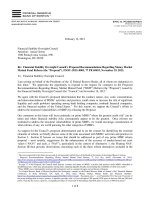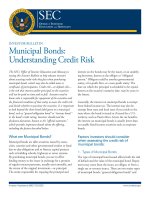Vote No Houston Bonds November 6, 2012 pot
Bạn đang xem bản rút gọn của tài liệu. Xem và tải ngay bản đầy đủ của tài liệu tại đây (5.35 MB, 76 trang )
Vote No Houston Bonds
November 6, 2012
Houston Community College $ 425,000,000.00
Houston Independent School District 1,900,000,000.00
Houston, City of 410,000,000.00
Chump Change $2,735,000,000.00
Vote No Houston Bonds
Definition of a Bond
(Webster’s New World Dictionary)
1) anything that binds, fastens, or unites
2) shackles
3) a binding agreement
4) an obligation imposed by a contract, promise, etc.
5) the status of goods kept in a warehouse until taxes
or duties are paid
6) an interest-bearing certificate issued by a
government or business, redeemable on a specific
date…
Texas Local Debt in Perspective - Overview
• Local governments in Texas issue debt to finance
construction and renovation of government facilities
(i.e., schools, public safety buildings, city halls and
county courthouses), public infrastructure (i.e., roads,
water and sewer systems) and various other projects
authorized by law. Key factors that affect a
government’s need and ability to borrow funds for
infrastructure development include population
changes, revenue sources, tax rates and levies, interest
rates and construction costs. Local governments issue
two main types of debt – tax (general obligation or GO)
and revenue. General obligation debt is secured by the
full faith and credit of the issuer’s tax revenue while
revenue debt is secured by a specified revenue source.
The BRB separates the local government
issuances into seven categories:
• Community Colleges (CCD)
• Public School Districts (School Districts)
• Cities, Towns, Villages (Cities)
• Water Districts (WD)
• Counties
• Other Special Districts (OSD)
• Health/Hospital Districts (HHD)
Moody’s Long Term Obligation Ratings
Total debt per capita (tax-supported and revenue) increased by
1.2 percent from $7,416 in FY 2010 to $7,507 in FY 2011. Debt
per capita has increased by 72.2 percent ($3,148) since 2002; the
state’s population has increased by 17.9 percent (3.9 million)
over the past 10 years.
Illustrates the local debt outstanding
over the past 10 fiscal years.
Debt Service
• Debt service is paid from either an ad valorem
tax or various revenue streams such as tuition,
technology and miscellaneous fees or lease
revenue.
Capital Appreciation Bonds
• Capital Appreciation Bonds are sold at a discounted price called the
par amount. Interest compounds semiannually and accumulates
over the life of the bond, and the amount paid at the maturity is
called the maturity value. Interest rates for CABs are generally
higher than bonds with current-pay interest. This structure keeps
payments low in the near term and delays interest payments until
maturity. The total debt outstanding figures are understated to the
extent that these bonds are reported at their par issuance price
rather than their maturity value.
• Premium CABs provide a lower initial stated par amount and are
issued to: (1) raise additional proceeds, (2) preserve debt limit, and
(3) help local governments reach tax-rate targets. Local
governments issue more premium CABs than non-premium CABs.
Certificates of Obligation
• During fiscal 2011 local governments issued $1.56 billion in
Certificates of Obligation (CO) or approximately 6.3 percent
of the total debt issued (Table 1.6). Debt service for COs is
paid from ad-valorem taxes and/or revenues and do not
require an election unless a valid petition requesting an
election is presented.
• Certificates of Obligations are authorized by the Certificate
of Obligation Act of 1971, Subchapter C of Chapter 271 of
the Texas Local Government Code and are issued to pay for
the construction of a public work; purchase of materials,
supplies, equipment, machinery, buildings, land, and rights-
of-way; and to pay for professional services such as
engineers, architects, attorneys and financial advisors.
Build America Bonds
• Build America Bonds were created by the American
Recovery and Reinvestment Act of 2009 and could be
issued as Tax Credit BABs or Direct-Payment BABs. Tax
Credit BABs provide a federal subsidy to investors equal to
35% of the interest payable, and Direct-Payment BABs
provide a direct federal subsidy payment to state and local
governmental issuers equal to 35% of the interest payable.
Authority to issue BABs expired in December 2010.
• Texas local governments accounted for approximately 6.0
percent ($10.94 billion) of the national BAB issuance of
$181.26 billion.
Houston Community College
The Board of Trustees of the Houston Community
College haven’t been good stewards of our tax
dollars. They have squandered away the hard
earned resources we have already given them.
Don’t reward them with more money to waste.
Vote No on November 6
www.tacc.org
42,000
44,000
46,000
48,000
50,000
52,000
54,000
56,000
58,000
2010 - 56,592
2011 - 51,613
2012 - 47,928
HCC Enrollment
-15.3% Enrollment Decrease
$0
$200,000,000
$400,000,000
$600,000,000
$800,000,000
$1,000,000,000
$1,200,000,000
2002 -
$180,453,487
2011 -
$635,813,210
2012 -
$1,060,813,210
HCC Bonded Debt
$0
$5,000
$10,000
$15,000
$20,000
$25,000
2002 - $3,336
2011 - $12,319
2012 - $22,133
HCC Bonded Debt Per Student
Tax Increase
• Current rate per $100 is .0972220
• Proposed rate per $100 is .1201220
23.6% Tax Increase
Community College Districts
• As of August 31, 2011 Community College Districts
with tax-supported debt outstanding had a per student
debt of $4,916, a decrease of 4.0 percent ($206) from
FY 2010. Since fiscal year 2007, the state’s per student
tax-supported debt has increased 42.3 percent from
$3,956 to $4,916 per student.
• CCDs with revenue debt outstanding had a per student
debt of $1,613, a decrease of 4.5 percent from FY
2010. Since FY 2007, the state’s per student revenue
debt has decreased 3.4 percent from $1,669 to $1,613
per student.
• Fall 2010: 56,592
• Fall 2011: 53,480
• Fall 2012: 49, 541
12.5% decline in enrollment
Federal and State funding are tied to enrollment.
Based on the continually declining enrollment,
funds are also decreasing, leading to additional
financial shortages.









